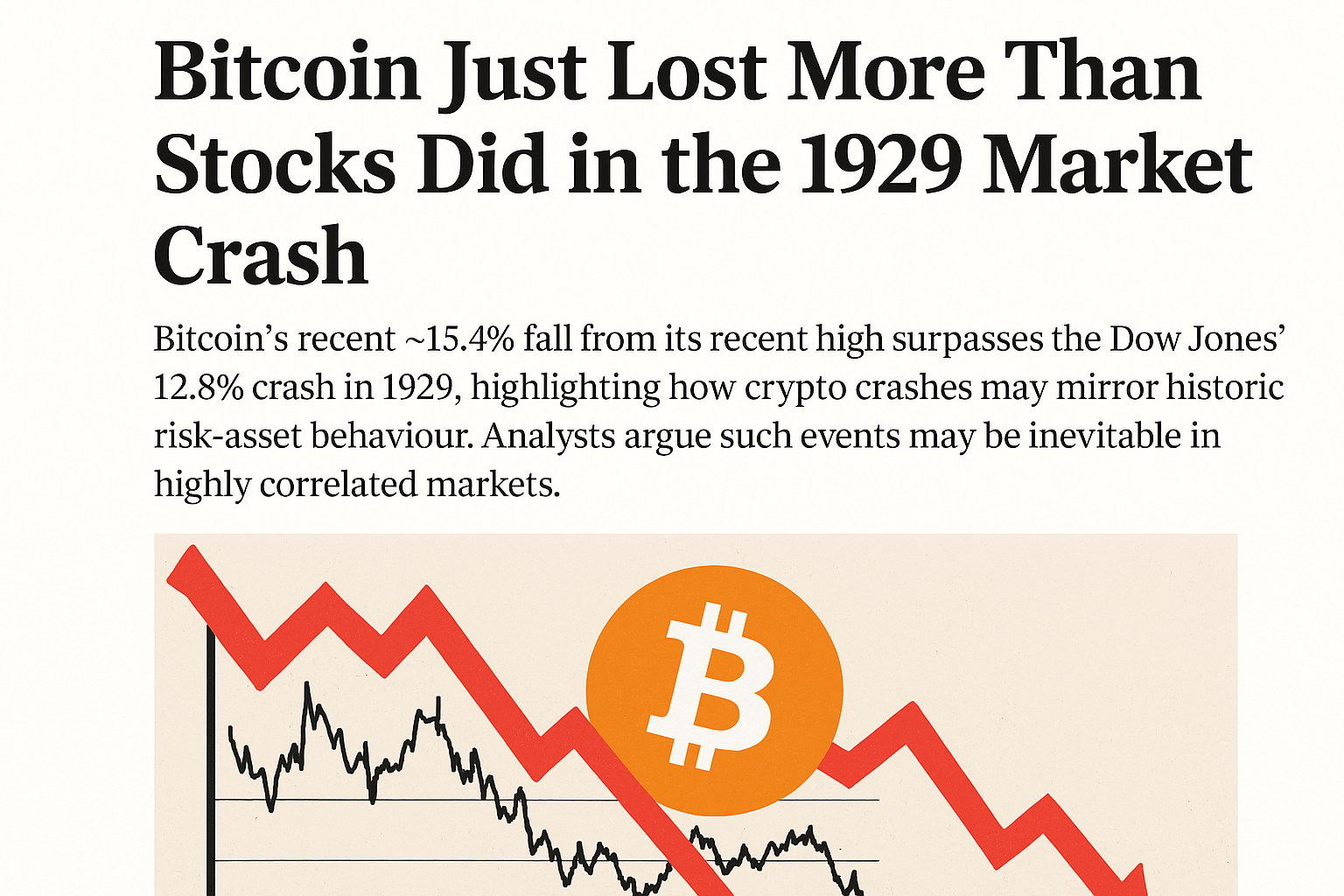In a striking turn of events, Bitcoin has just experienced a decline greater than the infamous 1929 stock market crash. Over the past week, the world’s largest cryptocurrency has fallen roughly 15.4% from its recent high — outpacing the 12.8% drop that marked the beginning of the Great Depression. For many investors, this comparison isn’t just a historical curiosity; it’s a warning about how today’s digital assets are behaving increasingly like traditional risk markets.
A Modern Echo of the Great Crash
The 1929 market collapse is remembered as one of the most catastrophic events in financial history. It triggered a decade-long depression, reshaping global economies and investor psychology for generations. Fast forward nearly a century, and Bitcoin’s swift fall has reignited debates about whether crypto markets, once hailed as a hedge against systemic risk, are now following the same patterns that doomed early 20th-century equities.
Bitcoin’s downturn mirrors the panic and cascading liquidation that characterized the 1929 crash — though the context is vastly different. Instead of margin calls and bank runs, we now have over-leveraged traders in perpetual futures, algorithmic liquidations, and real-time fear spreading across X (Twitter) and Discord. Yet, the emotional cycle of greed and fear remains the same.
Correlation: The Hidden Culprit
One of the most important takeaways from Bitcoin’s latest fall is how highly correlated it has become with broader risk assets. Analysts have pointed out that Bitcoin, once touted as “digital gold,” now behaves much like a high-beta tech stock — rallying during liquidity booms and crashing when global risk appetite fades.
The data backs this up. Over the past year, Bitcoin’s correlation with the Nasdaq 100 and S&P 500 has hovered near all-time highs. As central banks tighten monetary policy and global yields rise, speculative assets — from tech stocks to crypto — are taking the brunt of investor repricing.
This convergence between old and new markets challenges one of the foundational narratives of Bitcoin: that it is an uncorrelated store of value immune to traditional market cycles. Instead, the recent drop highlights a more sobering reality — Bitcoin is still a risk asset, deeply tied to global liquidity and investor sentiment.
Historical Parallels, Digital Speed
While comparing 1929 and 2025 may seem like apples to oranges, the psychological and structural parallels are undeniable. Both markets were marked by:
-
Excessive optimism: In 1929, it was radio and automobiles; today, it’s AI and blockchain.
-
Easy money: Loose credit conditions fueled speculative mania in both eras.
-
Sudden liquidity crunch: Once optimism faded, forced selling began, accelerating losses.
The key difference? Speed. What took weeks to unravel in 1929 can now happen in hours, thanks to 24/7 crypto trading and algorithmic markets. Bitcoin’s volatility compresses entire market cycles into days — a terrifying and fascinating phenomenon for traders and economists alike.
Inevitable Growing Pains
Analysts argue that such crashes are not anomalies but rather necessary recalibrations in a maturing market. Just as the 1929 crash paved the way for modern financial regulation, today’s crypto downturns may push the industry toward greater transparency and institutional oversight.
“This isn’t the end of Bitcoin,” says one analyst from MarketWatch. “It’s a reminder that volatility cuts both ways — and that markets, whether old or new, obey the same laws of human behavior.”
What Comes Next?
If history is any guide, periods of excessive pessimism often precede recovery. The Dow Jones eventually regained its 1929 peak — though it took decades. Bitcoin’s path may be faster, but not without pain. For long-term believers, the question isn’t whether Bitcoin will recover, but how many can stomach the turbulence before it does.
For now, Bitcoin’s fall below the 1929 benchmark serves as both a cautionary tale and a testament to how far financial history has come — and how much it still repeats itself, even in the digital age.



